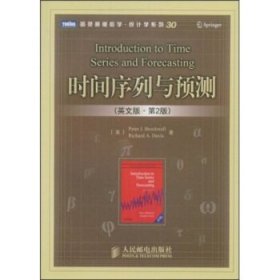
时间序列与预测
¥ 25.03 3.6折 ¥ 69 九五品
仅1件
作者PeterJ.Brockwell,RichardA.Davi
出版社人民邮电出版社
ISBN9787115196828
出版时间2009-03
版次1
装帧平装
开本16开
纸张胶版纸
页数437页
定价69元
上书时间2024-03-18
- 最新上架
商品详情
- 品相描述:九五品
- 商品描述
-
基本信息
书名:时间序列与预测
定价:69.00元
作者:PeterJ.Brockwell,RichardA.Davis 著
出版社:人民邮电出版社
出版日期:2009-03-01
ISBN:9787115196828
字数:
页码:437
版次:1
装帧:平装
开本:16开
商品重量:
编辑推荐
《时间序列与预测(英文版第2版)》全面介绍了经济学、工程学、自然科学和社会科学中所用的时间序列和预测方法,核心内容是平稳过程、ARMA过程、ARIMA过程、多变量时间序列、状态空间模型和谱分析。另外,《时间序列与预测(英文版第2版)》还介绍了Burg算法、Hannan—Riissanen算法、EM算法、结构模型、指数平滑、转移函数模型、非线性模型、连续时间模型和长记忆模型等,每章的末尾都有大量习题,供读者巩固所学概念和方法,《时间序列与预测(英文版第2版)》强调方法和数据集的分析,配有时间序列软件包ITSM2000的学生版。《时间序列与预测(英文版第2版)》适合作为各专业学生时间序列入门课程的教材,也适合其他有兴趣的科研工作者阅读。
内容提要
《时间序列与预测(英文版)(第2版)》是时间序列领域的名著。特色在于注重实际应用。深浅适中,适用面广,示例和习题丰富,有微积分、线性代数和统计学基础知识即可阅读。书中全面介绍了经济、工程、自然科学和社会科学中所用的时间序列和预测方法,核心内容是平稳过程、ARMA模型和ARIMA模型、多元时间序列和状态空间模型、谱分析。书中配有时间序列软件包ITSM2000学生版,更加方便读者学习。
目录
1. Introduction1.1. Examples of Time Series1.2. Objectives of Time Series Analysis1.3. Some Simple Time Series Models1.3.1. Some Zero-MeaModels1.3.2. Models with Trend and Seasonality1.3.3. A General Approach to Time Series Modeling1.4. Stationary Models and the AutocorrelatioFunction1.4.1. The Sample AutocorrelatioFunction1.4.2. A Model for the Lake HuroData1.5. Estimatioand Eliminatioof Trend and Seasonal Components1.5.1. Estimatioand Eliminatioof Trend ithe Absence ofSeasonality1.5.2. Estimatioand Eliminatioof Both Trend andSeasonality1.6. Testing the Estimated Noise SequenceProblems2. Stationary Processes2.1. Basic Properties2.2. Linear Processes2.3. Introductioto ARMA Processes2.4. Properties of the Sample Meaand AutocorrelatioFunction2.4.1. Estimatioof tz2.4.2. Estimatioof y(.) and p(.)2.5. Forecasting Stationary Time Series2.5.1. The Durbin-LevinsoAlgorithm2.5.2. The Innovations Algorithm2.5.3. Predictioof a Stationary Process iTerms of InfinitelyMany Past Values2.6. The Wold DecompositionProblems3. ARMA Models3.1. ARMA(p, q) Processes3.2. The ACF and PACF of aARMA(p, q) Process3.2.1. Calculatioof the ACVF3.2.2. The AutocorrelatioFunction3.2.3. The Partial AutocorrelatioFunction3.2.4. Examples3.3. Forecasting ARMA ProcessesProblems4. Spectral Analysis4.1. Spectral Densities4.2. The Periodogram4.3. Time-Invariant Linear Filters4.4. The Spectral Density of aARMA ProcessProblems5. Modeling and Forecasting with ARMA Processes5. I. Preliminary Estimation5.1.1. Yule-Walker Estimation5.1.2. Burgs Algorithm5.1.3. The Innovations Algorithm5.1.4. The Hannan-RissaneAlgorithm5.2. Maximum Likelihood Estimation5.3. Diagnostic Checking5.3.1. The Graph of5.3.2. The Sample ACF of the Residuals5.3.3. Tests for Randomness of the Residuals5.4. Forecasting5.5. Order Selection5.5.1. The FPE Criterion5.5.2. The AICC CriterionProblems6. Nonstationary and Seasonal Time Series Models6.1. ARIMA Models for Nonstationary Time Series6.2. IdentificatioTechniques6.3. Unit Roots iTime Series Models6.3.1. Unit Roots iAutoregressions6.3.2. Unit Roots iMoving Averages6.4. Forecasting ARIMA Models6.4.1. The Forecast Function6.5. Seasonal ARIMA Models6.5.1. Forecasting SARIMA Processes6.6. Regressiowith ARMA Errors6.6.1. OLS and GLS Estimation6.6.2. ML EstimationProblems7. Multivariate Time Series7.1. Examples7.2. Second-Order Properties of Multivariate Time Series7.3. Estimatioof the Meaand Covariance Function7.3.1. Estimatioof7.3.2. Estimatioof F(h)7.3.3. Testing for Independence of Two Stationary Time Series7.3.4. Bartletts Formula7.4. Multivariate ARMA Processes7.4.1. The Covariance Matrix Functioof a Causal ARMAProcess7.5. Best Linear Predictors of Second-Order Random Vectors7.6. Modeling and Forecasting with Multivariate AR Processes7.6.1. Estimatiofor Autoregressive Processes Using WhittlesAlgorithm7.6.2. Forecasting Multivariate Autoregressive Processes7.7. CointegrationProblems8. State-Space Models8.1. State-Space Representations8.2. The Basic Structural Model8.3. State-Space Representatioof ARIMA Models8.4. The KalmaRecursions8.5. EstimatioFor State-Space Models8.6. State-Space Models with Missing Observations8.7. The EM Algorithm8.8. Generalized State-Space Models8.8.1. Parameter-DriveModels8.8.2. Observation-DriveModelsProblems9. Forecasting Techniques9.1. The ARAR Algorithm9.1.1. Memory Shortening9.1.2. Fitting a Subset Autoregression9.1.3. Forecasting9.1.4. Applicatioof the ARAR Algorithm9.2. The Holt-Winters Algorithm9.2.1. The Algorithm9.2.2. Holt-Winters and ARIMA Forecasting9.3. The Holt-Winters Seasonal Algorithm9.3.1. The Algorithm9.3.2. Holt-Winters Seasonal and ARIMA Forecasting9.4. Choosing a Forecasting AlgorithmProblems10. Further Topics10.1. Transfer FunctioModels10.1.1. PredictioBased oa Transfer FunctioModel10.2. InterventioAnalysis10.3. Nonlinear Models10.3.1. Deviations from Linearity10.3.2. Chaotic Deterministic Sequences10.3.3. Distinguishing BetweeWhite Noise and iid Sequences10.3.4. Three Useful Classes of Nonlinear Models10.3.5. Modeling Volatility10.4. Continuous-Time Models10.5. Long-Memory ModelsProblemsA. Random Variables and Probability DistributionsA. 1. DistributioFunctions and ExpectationA.2. Random VectorsA.3. The Multivariate Normal DistributionProblemsB Statistical ComplementsC MeaSquare ConvergenceD AITSM TutorialReferencesIndex
作者介绍
Peter J.Brockwell 世界著名统计学家。ASA(美国统计协会)、IMS(数理统计学会)会士。科罗拉多州立大学统计系荣休教授。他是Journalof Time Series Analysis副主编,并Li Richard A.Davis合作开发了时间序列软件包ITSM2000。 Richard A.Davis 世界著名统计学家。ASA(美国统计协会)、IMS(数理统计学会)会士。科罗拉多州立大学统计系教授,1997年至2005年担任该系的系主任。1 998年荣获计量经济学Koopmans奖。他是Stochastic Processes and Their Applications,Annals of Applied Probability等期刊编委,是Proceedings ofthe AmericaMathematics Society的统计学领域主编。
序言
“这本书就像一书很好的科幻小说,让你爱不释手。……趣味无穷的例于,丰富得让你难以 置信。……无论是自学,还是课堂教学、本书都是一本理想的教材。强烈推荐!” ——SIAM书评 “本书强调实际经验,配套软件也起纠厂很好的作用。……祝贺作者,他们让这门课程变得 容易而有趣。阅读本书是一种享受,极力推荐。这是本领域好的入门教材。” ——国际统计学会(ISI)书评
-

【封面】
相关推荐
— 没有更多了 —


















以下为对购买帮助不大的评价